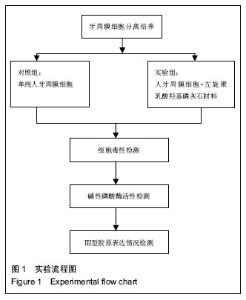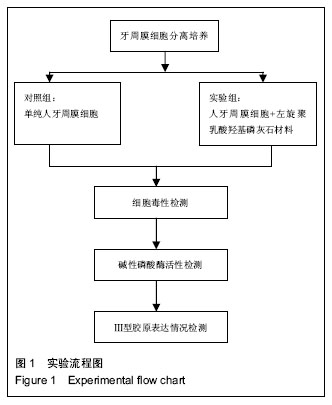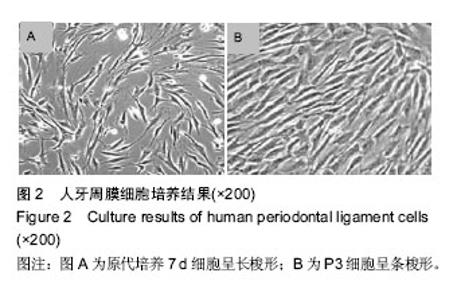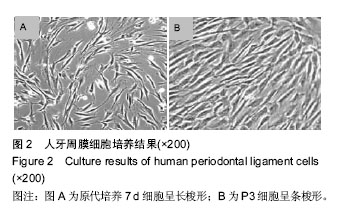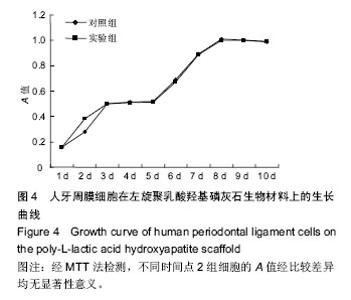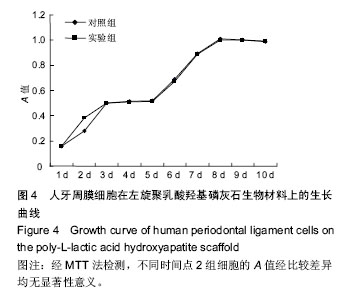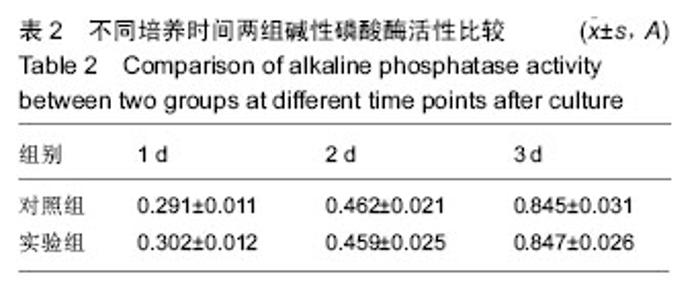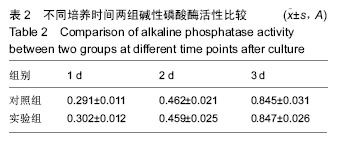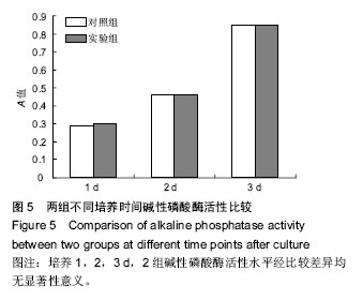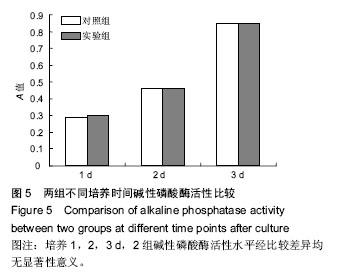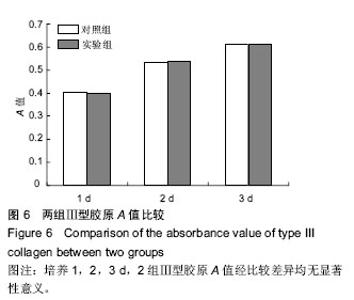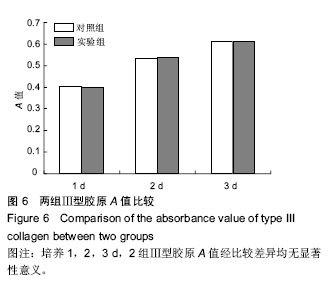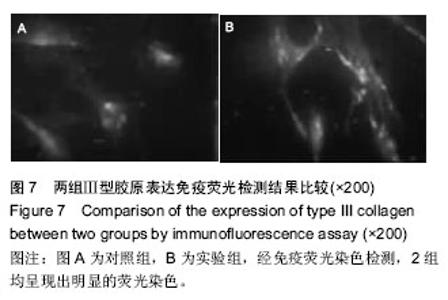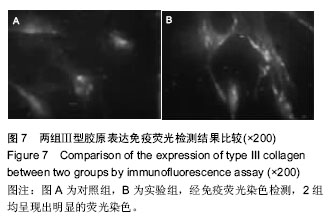Chinese Journal of Tissue Engineering Research ›› 2016, Vol. 20 ›› Issue (34): 5082-5088.doi: 10.3969/j.issn.2095-4344.2016.34.011
Previous Articles Next Articles
Growth of human periodontal ligament cells on the poly-L-lactic acid hydroxyapatite
Gao Yong-zhi1, Yin Zhi-yuan2
- 1Department of Stomatology, First Affiliated Hospital of Qiqihar Medical University, Qiqihar 161041, Heilongjiang Province, China; 2Department of Stomatology, Health Service Center of Jiansanjiang Qixing Community in Heilongjiang, Heilongjiang 156300, China
-
Received:2016-05-21Online:2016-08-19Published:2016-08-19 -
About author:Gao Yong-zhi, Studying for master’s degree, Attending physician, Department of Stomatology, First Affiliated Hospital of Qiqihar Medical University, Qiqihar 161041, Heilongjiang Province, China
CLC Number:
Cite this article
Gao Yong-zhi, Yin Zhi-yuan. Growth of human periodontal ligament cells on the poly-L-lactic acid hydroxyapatite[J]. Chinese Journal of Tissue Engineering Research, 2016, 20(34): 5082-5088.
share this article
| [1] 王琳,冯海兰,梅芳,等.人牙周膜细胞在左旋聚乳酸/羟基磷灰石生物材料上的生长观察[J].解剖学报, 2008,39(4): 573-577. [2] 王琳,邓旭亮,梅芳,等.电纺左旋聚乳酸和左旋聚乳酸羟基磷灰石纳米纤维细胞相容性的比较研究[J].口腔颌面修复学杂志,2007,8(2):83-86. [3] 鲁红,吴织芬,田宇,等.应用细胞-支架构建方式的组织工程方法促进牙周组织再生的实验研究[J].牙体牙髓牙周病学杂志,2005,15(1):14-18. [4] 鲁红,吴织芬,田宇,等.狗牙周膜细胞三维立体培养的体外实验研究[J].实用口腔医学杂志,2003,19(4):304-307. [5] 闫福华,郑碧琼,林敏魁,等.组织工程用于修复慢性牙周组织缺损的动物实验研究[J].口腔医学研究, 2005,21(6): 593-597. [6] 王烟岚,王萧萧,陈天宇,等.牙周膜干细胞与牙周膜细胞甲状旁腺激素受体表达的比较[J].中国组织工程研究, 2015, 19(10):1562-1569. [7] 唐倩,孙文娟,黄南楠,等.新型壳聚糖-胶原支架与牙周膜细胞的生物相容性[J].中国组织工程研究, 2013,17(38): 6766-6772. [8] Wu C, Zhou Y, Lin C, et al. Strontium-containing mesoporous bioactive glass scaffolds with improved osteogenic/cementogenic differentiation of periodontal ligament cells for periodontal tissue engineering.Acta Biomaterialia. 2012;8(10):3805-3815. [9] 王方,谢诚,吴国锋,等.组织工程牙周膜细胞片的体内实验研究[J].实用口腔医学杂志,2011,27(2):177-180. [10] 鲁红,吴织芬,田宇,等.异体脱矿松质骨基质和纳米羟基磷灰石材料应用于牙周组织工程中的可行性探讨[J].中国临床康复,2002,6(17):2538-2539. [11] Zheng L, Huang Y, Song W, et al. Fluid shear stress regulates metalloproteinase-1 and 2 in human periodontal ligament cells: Involvement of extracellular signal-regulated kinase (ERK) and P38 signaling pathways. J Biomech. 2012;45(14):2368-2375. [12] Moshaverinia A, Xu X, Chen C, et al. Application of stem cells derived from the periodontal ligament orgingival tissue sources for tendon tissue regeneration.Biomaterials. 2014;35(9):2642-2650. [13] 崔菊萍,王新,邹建明,等.丝蛋白应用于牙周组织工程的可行性[J].中国组织工程研究与临床康复, 2011,15(42): 7835-7838. [14] Han P, Wu C, Chang J, et al. The cementogenic differentiation of periodontal ligament cells via the activation of Wnt/β-catenin signalling pathway by Li + ions released from bioactive scaffolds.Biomaterials. 2012;33(27):6370-6379. [15] 鲁红,吴织芬,田宇,等.一种新型纳米羟基磷灰石材料应用于牙周组织工程的可行性研究[J].牙体牙髓牙周病学杂志, 2005,15(1):6-9. [16] Yang Z, Ren L, Deng F, et al. Low-intensity pulsed ultrasound induces osteogenic differentiation of human periodontal ligament cells through activation of bone morphogenetic protein-smad signaling. J Ultras Med. 2014;33(5):865-873. [17] 程远,曾照芳,朱俊,等.碱性成纤维细胞生长因子对牙周膜细胞内核心蛋白多糖基因表达的影响[J].中国组织工程研究与临床康复,2010,14(11):2068-2071. [18] 马宁,张莉,边立新,等.牙周膜细胞与壳聚糖-聚磷酸三钙复合材料生物相容性研究[J].中国实验诊断学, 2007,11 (10):1313-1316. [19] Kim YT, Park JC, Choi SH, et al. The dynamic healing profile of human periodontal ligament stem cells: Histological and immunohistochemical analysis using an ectopic transplantation model. J Periodontal Res. 2012;47(4):514-524. [20] Liu W, Konermann A, Guo T, et al. Canonical Wnt signaling differently modulates osteogenic differentiation of mesenchymal stem cells derived from bone marrow and from periodontal ligament under inflammatory conditions. Biochimicaet Biophysica Acta. 2014;1840(3):1125-1134. [21] Jung IH, Park J, Kim JC, et al. Novel application of human periodontal ligament stem cells and water-soluble chitin for collagen tissue regeneration: In vitro and in vivo investigations.Tissue Eng. 2012;18 (5/6): 643-653. [22] Capretto L, Mazzitelli S, Colombo G, et al.Production of polymeric micelles by microfluidic technology for combined drug delivery: Application to osteogenic differentiation of human periodontal ligament mesenchymal stem cells (hPDLSCs). Int J Pharm. 2013;440(2):195-206. [23] 张彦聪,顾相伶,刘洪玲,等.人牙周膜细胞在透明质酸钠/纳米羟磷灰石支架上的黏附与生长[J].山东医药, 2013, 53(38):15-17. [24] Ji K, Liu Y, Lu W, et al. Periodontal tissue engineering with stem cells from the periodontal ligament of human retained deciduous teeth. J Periodontal Res. 2013; 48(1):105-116. [25] 鲁红,吴织芬.纳米羟基磷灰石材料复合碱性成纤维细胞因子促进牙周组织再生的实验研究[C].//2011第九次全国牙周病学学术会议论文集,2011:124-124. [26] Benatti BB, Silvério KG, Casati MZ, et al.Physiological Features of Periodontal Regeneration and Approaches for Periodontal Tissue Engineering Utilizing Periodontal Ligament Cells. J Biosci Bioeng. 2007;103(1):1-6. [27] 刘泉,莫安春.钇-羟基磷灰石纳米微粒对人牙周膜细胞生物学行为的影响[J].牙体牙髓牙周病学杂志, 2008,18(3):139-143. [28] 张清彬,张兆强,郑日成,等.Leptin对人牙周膜细胞骨向分化作用的实验研究[J].北京口腔医学,2012,20(2):77-79. [29] 孙卫斌.纳米羟基磷灰石诱导人牙周膜细胞骨化分化的研究[D].四川大学,2005. [30] 石铁,王泓杰,高秀秋,等.纳米羟基磷灰石及其复合材料对牙周膜细胞的影响[J].中国组织工程研究与临床康复, 2009,13(3):553-556. [31] Yang Z,Jin F,Zhang X, et al.Tissue engineering of cementum/periodontal-ligament complex using a novel three-dimensional pellet cultivation system for human periodontal ligament stem cells. Tissue Eng Part C Methods. 2009;15(4):571-581. [32] 孙卫斌,吴亚菲,丁一,等.纳米羟基磷灰石对人牙周膜细胞增殖活性的影响[J].东南大学学报(自然科学版), 2004, 34(6):802-805. [33] 毛钊,毛曦,储成林,等.人牙周膜细胞接种于纳米-羟基磷灰石上的形态学研究[J].东南国防医药, 2008,10(3):161-163. [34] 鲁红,吴织芬,田宇,等.人牙周膜细胞体外三维立体培养模型的建立[J].牙体牙髓牙周病学杂志, 2002,12(3):132-134. [35] 吴晓楠,苗雷英,刘玉,等.电纺聚己内酯/Ⅰ型胶原蛋白/纳米羟基磷灰石复合材料的制备及其生物相容性研究[J].口腔医学,2015,(4):245-249. [36] Yang H, Gao LN, An Y, et al. Comparison of mesenchymal stem cells derived from gingival tissue and periodontal ligament in different incubation conditions. Biomaterials. 2013;34(29):7033-7047. [37] Wen Y,Lan J,Huang H,et al.Application of eGFP to label human periodontal ligament stem cells in periodontal tissue engineering. Arch Oral Biol. 2012;57(9):1241-1250. [38] 孙卫斌,刘天佳,吴亚菲,等.纳米羟基磷灰石诱导人牙周膜细胞骨化分化的研究[C].//四川省口腔医学会成立大会暨第八次四川省口腔医学学术会议论文集,2005:35-38. [39] 孙卫斌,吴亚菲,丁一,等.纳米羟基磷灰石诱导人牙周膜细胞碱性磷酸酶表达的研究[J].中华口腔医学杂志, 2006, 41(6):348-349. |
| [1] | Zhang Tongtong, Wang Zhonghua, Wen Jie, Song Yuxin, Liu Lin. Application of three-dimensional printing model in surgical resection and reconstruction of cervical tumor [J]. Chinese Journal of Tissue Engineering Research, 2021, 25(9): 1335-1339. |
| [2] | Zeng Yanhua, Hao Yanlei. In vitro culture and purification of Schwann cells: a systematic review [J]. Chinese Journal of Tissue Engineering Research, 2021, 25(7): 1135-1141. |
| [3] | Xu Dongzi, Zhang Ting, Ouyang Zhaolian. The global competitive situation of cardiac tissue engineering based on patent analysis [J]. Chinese Journal of Tissue Engineering Research, 2021, 25(5): 807-812. |
| [4] | Wu Zijian, Hu Zhaoduan, Xie Youqiong, Wang Feng, Li Jia, Li Bocun, Cai Guowei, Peng Rui. Three-dimensional printing technology and bone tissue engineering research: literature metrology and visual analysis of research hotspots [J]. Chinese Journal of Tissue Engineering Research, 2021, 25(4): 564-569. |
| [5] | Chang Wenliao, Zhao Jie, Sun Xiaoliang, Wang Kun, Wu Guofeng, Zhou Jian, Li Shuxiang, Sun Han. Material selection, theoretical design and biomimetic function of artificial periosteum [J]. Chinese Journal of Tissue Engineering Research, 2021, 25(4): 600-606. |
| [6] | Liu Fei, Cui Yutao, Liu He. Advantages and problems of local antibiotic delivery system in the treatment of osteomyelitis [J]. Chinese Journal of Tissue Engineering Research, 2021, 25(4): 614-620. |
| [7] | Li Xiaozhuang, Duan Hao, Wang Weizhou, Tang Zhihong, Wang Yanghao, He Fei. Application of bone tissue engineering materials in the treatment of bone defect diseases in vivo [J]. Chinese Journal of Tissue Engineering Research, 2021, 25(4): 626-631. |
| [8] | Zhang Zhenkun, Li Zhe, Li Ya, Wang Yingying, Wang Yaping, Zhou Xinkui, Ma Shanshan, Guan Fangxia. Application of alginate based hydrogels/dressings in wound healing: sustained, dynamic and sequential release [J]. Chinese Journal of Tissue Engineering Research, 2021, 25(4): 638-643. |
| [9] | Chen Jiana, Qiu Yanling, Nie Minhai, Liu Xuqian. Tissue engineering scaffolds in repairing oral and maxillofacial soft tissue defects [J]. Chinese Journal of Tissue Engineering Research, 2021, 25(4): 644-650. |
| [10] | Xing Hao, Zhang Yonghong, Wang Dong. Advantages and disadvantages of repairing large-segment bone defect [J]. Chinese Journal of Tissue Engineering Research, 2021, 25(3): 426-430. |
| [11] | Yang Junhui, Luo Jinli, Yuan Xiaoping. Effects of human growth hormone on proliferation and osteogenic differentiation of human periodontal ligament stem cells [J]. Chinese Journal of Tissue Engineering Research, 2021, 25(25): 3956-3961. |
| [12] | Yang Caihui, Liu Qicheng, Dong Ming, Wang Lina, Zuo Meina, Lu Ying, Niu Weidong. Serine/threonine protein kinases can promote bone destruction in mouse models of chronic periapical periodontitis [J]. Chinese Journal of Tissue Engineering Research, 2021, 25(23): 3654-3659. |
| [13] | Chen Siqi, Xian Debin, Xu Rongsheng, Qin Zhongjie, Zhang Lei, Xia Delin. Effects of bone marrow mesenchymal stem cells and human umbilical vein endothelial cells combined with hydroxyapatite-tricalcium phosphate scaffolds on early angiogenesis in skull defect repair in rats [J]. Chinese Journal of Tissue Engineering Research, 2021, 25(22): 3458-3465. |
| [14] | Wang Hao, Chen Mingxue, Li Junkang, Luo Xujiang, Peng Liqing, Li Huo, Huang Bo, Tian Guangzhao, Liu Shuyun, Sui Xiang, Huang Jingxiang, Guo Quanyi, Lu Xiaobo. Decellularized porcine skin matrix for tissue-engineered meniscus scaffold [J]. Chinese Journal of Tissue Engineering Research, 2021, 25(22): 3473-3478. |
| [15] | Mo Jianling, He Shaoru, Feng Bowen, Jian Minqiao, Zhang Xiaohui, Liu Caisheng, Liang Yijing, Liu Yumei, Chen Liang, Zhou Haiyu, Liu Yanhui. Forming prevascularized cell sheets and the expression of angiogenesis-related factors [J]. Chinese Journal of Tissue Engineering Research, 2021, 25(22): 3479-3486. |
| Viewed | ||||||
|
Full text |
|
|||||
|
Abstract |
|
|||||
